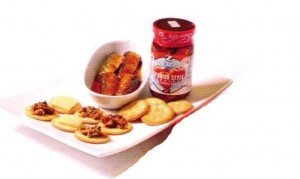
The late Digon Vocalan told me how sardines figure prominently in the Holy Week menu of the residents of Angono. The canned cooked fish is the main ingredient for soup, as sahog (ingredient) for pancit or eaten by itself, the sauce soaking the rice with its rich tomato flavor.
Sardines became a cheap substitute for the expensive fish on the abstinence days of Lent. Cheap and convenient and well-loved, it is portable food that doesn’t need to be heated, cooked further, flavored.
But it can be cooked and flavored. Our favorite sardine recipe at home adds vinegar and soy sauce to the crushed sardine, and the tomato sauce added with water to make the whole thing soupy. It extends the dish so one small can can feed a family of four.
Fallback food
Sardines are the fallback food of my husband in case he doesn’t feel like eating what’s served at home. (He would have been banished from my mother’s table and punished.) The problem is that he has developed a liking for perhaps one of the more expensive sardine brands in the grocery. Called Mabuti, it’s imported from Portugal.
The fish inside are small, unlike some local brands that carry the bigger-sized variety. They’re lined very close together—perhaps the basis for the saying “packed like sardines.”
Mabuti reminds the older generation of what sardines were like in their time, not only in size but also in flavor. The can is small and thin. Its flavor is more subtle than the other brands you find today, good to the last lick of the sauce on the plate.
Yet my husband will also never forget even the cheaper brand that his parents’ farmhands used to make whenever he and his father visited the rice fields in the barrio. There he tasted what for him remains the best noodle soup with sardines. And he asks every time if we can do the same at home.
Prestige, feasting
In Davao, I was told that the Bagobo tribe will gladly exchange their native chicken for a can of sardines. Other indigenous tribes such as the Mangyan of Mindoro and the Aetas also prefer sardines. It’s not only the taste they love but also the prestige of having a can and eating its contents. Early Aetas were known to rub the residual sauce on their bodies and hair to proudly inform members of their tribe that they had just eaten sardines.
In one town in Albay, my Bicolana friend said having sardines merits a feast, like having lechon during important occasions. “Pa-sardinas-sardinas ka na lang,” were words that teased the sardine owner, indicating how lucky the person is.
In Zamboanga, making sardines seems to be a good business prospect. Two of the famous brands sold in supermarkets here are made in Dipolog City. Tourists get the bottled products as pasalubong (gifts). Unlike the canned commercial sardines, the bottled variety gives the buyer a choice of sauces—tomato, corn oil or olive oil.
My own sardines
My own sardine story is about how my husband’s two aunts taught me how to make my own sardines. They used Nora Daza’s recipe in her first cookbook, a recipe of former Manila Mayor Arsenio Lacson that she obtained from her friends. The recipe used small bangus (plentiful during floods) and the sauce consisted of olive oil, soy sauce, brandy, pickles and olives.
The bangus heads were cut off and the aunts said to cook those as paksiw. The body, with its bones, scales and all, were lined in layers in a pressure cooker. Cooking took an hour and the result wasn’t like at all like canned sardines. But it was so good, and it tempted me to try again and again.
But I never quite solved how not to make the sauce cling to the bottom of the cooker. My sardines always end up with less sauce than I intended. So sad because the bangus sardines are better eaten with rice.
But it has been a while since I made the bangus sardines. First of all, it’s difficult to get small bangus these days. It’s also easier to just buy from the grocery even if it’s not really the same.
E-mail pinoyfood04@yahoo.com











































